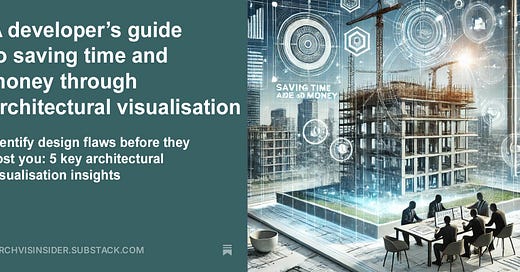A Developer’s guide to saving time and money through architectural visualisation
Identify design flaws before they cost you: 5 key architectural visualisation insights
Happy New Year and welcome to the inaugural edition of the Architectural Visualisation Insider!
In this first edition, we’ll explore how developers can avoid costly mistakes and delays by catching design issues early through architectural visualisation.
This newsletter focuses on how developers can leverage architectural visualisation to identify design issues early, ultimately saving time and money during the construction process.
If you're a developer, your project timelines and budgets are everything. Finding and fixing issues once the build is underway can be both expensive and frustrating.
So, how can developers spot design issues early and avoid costly delays before construction begins?
By the end of this newsletter , you’ll discover 5 ways architectural visualisation can help you identify design flaws before they become costly problems, saving you both time and money.
The cost of waiting until it's too late.
In the world of construction and development, there’s always a rush to move from concept to execution. But often, this rush leads to oversight. Problems that could have been caught earlier, such as layout inefficiencies or aesthetic mismatches, are only identified once the project is too far along to make significant changes.
Imagine you're weeks into the construction phase. Everything seemed fine until you realise that the layout of the building isn’t as functional as expected, or the finishes you approved don’t quite match the initial vision. Not only does this add time and cost to the project, but it also risks disappointing clients who have already envisioned the final product.
This is where architectural visualisation comes into play. By creating 3D renderings early on, developers can see their designs in full, visualised glory, long before work on site begins. But the question remains: How does this lead to saving time and costs?
The common pitfalls developers face without early design clarity
Now, you’re probably thinking: “Can visualisation really make that much of a difference?”
Here’s the thing about this answer: It’s not just about making things look pretty, it’s about making informed decisions that can save a lot of time and money.
Let’s talk about why this is important. Traditional development methods often involve costly rework, whether it’s adjusting layouts, switching finishes, or redoing elements that didn’t meet expectations. With architectural visualisation, you have the power to spot problems before they become costly setbacks.
So, how can architectural visualisation help developers catch these issues early?
Let’s dive into the specifics.
5 Ways developers can save time and cut costs with architectural visualisation
Here are 5 ways architectural visualisation helps developers identify and fix design issues before construction starts:
Improved Layout Decisions:
Visualisation allows you to see how spaces flow and function, enabling early adjustments to ensure optimal use of space and efficiency.Better Design Clarity:
Clear, detailed visuals help everyone, from architects to clients, understand the design, reducing miscommunications and costly mistakes.Spot Aesthetic Issues Early:
Visualising finishes, materials, and colours lets you evaluate and tweak aesthetic choices before committing to expensive materials.Faster Client Approvals:
With realistic visuals, clients can more easily see and approve designs, speeding up the decision-making process and reducing revisions.Identifying Buildability Issues:
By simulating the construction process digitally, you can catch potential structural or logistical issues early, before construction begins.
These 5 methods illustrate just how powerful architectural visualisation can be for developers. By identifying problems early, you’re not just avoiding frustration, you’re preventing costly delays and ensuring your projects stay on budget and on time.
The bigger picture: How early clarity drives better outcomes
What it means to you: Early visualisation isn’t just about saving money—it’s about delivering a higher quality, more refined product. You’ll not only avoid setbacks but also improve the overall design quality.
By proactively addressing issues with visualisation, you’ll ensure that your project has the best chance of success. It’s about making informed decisions that will ultimately benefit you, your clients, and the entire team involved.
Many developers still rely on traditional methods of reviewing plans and sketches, which can miss critical issues. Architectural visualisation shifts the process to a more visual, intuitive approach, giving everyone a clearer understanding and reducing the risk of mistakes.
We’ve explored how architectural visualisation can save developers time and money by identifying design issues early, and we’ve broken down 5 specific ways to take advantage of this powerful tool.
Key Takeaways:
Visualisation helps you make layout and design decisions before construction starts.
Spotting aesthetic and buildability issues early prevents costly delays.
Faster client approvals and fewer revisions lead to smoother project timelines.
If you’re ready to streamline your development process, improve your design clarity, and cut costs, architectural visualisation might be your new best friend. Don’t let costly mistakes slow you down, start visualising your projects today!
Hope you enjoyed this weeks edition of the Architectural Visualisation Insider, if you haven’t already done so, subscribe to be notified of future editions.
Speak soon,
Jamie
P.S. We’re hosting a free webinar, ‘An Introduction to Architectural Visualisation’. Check the link to confirm your preferred time and dates. We look forward to seeing you there!




